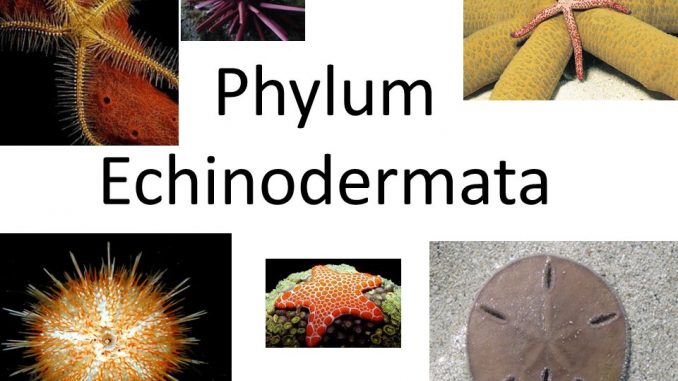
General characteristics of Phylum Echinodermata
- (Echinos: Spines; derma: Skin)
- Kingdom: Animalia
- Habitat: These are exclusively marine
- Grade of organization: organ system grade
- Germ layer: triploblastic
- Symmetry: Adults are radially symmetrical while the larvae are bilaterally symmetrical.
- Coelom: present ( coelomate)
- Body without segmentation
- The shape of the body is flat, star like, spherical or elongated.
- Head is absent
- Presence of tube feet
- Presence of water vascular system
- Mouth is present on ventral side while anus is present on dorsal side
- Respiration: by papule, gills or clocal respiratory tree
- Nervous system: absent, they are brainless organism.
- Circulatory system: is reduced, heart is absent
- Blood has no pigment.
- Digestive system: complete
- Excretory system: absent
- Sexes: mostly dioecious, rarely monocious
- Reproduction:
- Sexual: by gamatic fusion
- Asexual: regeneration
- Fertilization: external
- Development: indirect with characteristic larvae
Classification of phylum Echinodermata
It is divided into 5 classes:
- Asteroidea
- Ophiuroidea
- Echinoidea
- Holothuroidea
- Crinoidea
Class 1 Asteroidea
- Body is flattened star shaped with five arms
- They possesses tube feet with a sucker
- Presence of calcareous plates and movable spines.
- Respiratory organ: papulae
- Examples: Asterias (Star fish), Astropecten, Zoraster, Oreaster
Class 2 Ophiuroidea
- Body is flat with pentamerous disc
- They possess a long arm which is sharply demarcated from the central disc.
- They possesses tube feet without sucker
- Anus and intestine are absent
- Respiratory organ: Bursae
- Examples: Ophiderma, ophiothrix, Astrophyton, Amphuria, etc
Class 3 Echinoidea
- Body is disc-like hemi-spherical
- They are devoid of arms or free-rays.
- They possesses tube feet with a sucker.
- They possess compact skeleton and movable spines.
- Examples: Echinus (Sea urchin), Cidaris, Arbacia, Echinocardium. Diadema
Class 4 Holothuroidea
- Body is elongated in the oral-aboral axis and it is like cucumber.
- They have no arms, spines and pedicellariae.
- The tube feet are sucking type which is modified into tentacles and form a circle around mouth.
- Respiratory organ: cloacal respiratory tree
- Examples: Cucumaria (Sea cucumber), Holothuria, Mesothuria, etc
Class 5 Crinoidea
- Body is star shaped
- Some of the forms were extinct and living forms.
- Arms bifurcated, with two pinnules.
- They have tube feet without suckers
- Examples: Neometra, Antedon, Rhizocrinus, etc
